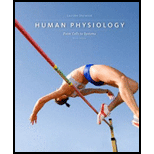
Human Physiology: From Cells to Systems (MindTap Course List)
9th Edition
ISBN: 9781285866932
Author: Lauralee Sherwood
Publisher: Cengage Learning
expand_more
expand_more
format_list_bulleted
Textbook Question
Chapter 5, Problem 1UC
Discuss the function of each of the following: astrocytes, oligodendrocytes, ependymal cells, in icroglia, cranium, vertebral column, meninges, cerebrospinal fluid, and blood—brain barrier.
Expert Solution & Answer
Trending nowThis is a popular solution!

Students have asked these similar questions
Name major functions associated with the following brain struc-tures: medulla oblongata, cerebellum, tectum, thalamus, hypothala-mus, cerebrum, limbic system.
Match the neuroglia with the correct function:
A. Satellite cells
B. Schwann Cells
C. Oligodendrocytes
D. Ependymal
E. Microglia
F. Astrocytes
1. Cells that produce the myelin in the PNS.
2. Cells that produce myelin in the CNS
3. Phagocytes that dispose debris like dead brain cells and bacteria
4. Anchors and braces neurons with cellular projections
5. Cells have cilia that help circulate the cerebrospinal fluid
6. Cells help cushion and protect neurons in the PNS
7. Cells serve as a medium for diffusion between capillaries and neurons
8. Cells line cavities of the brain and spinal cord
Identify the five secondary vesicles, and list the adult brain structures they form.
Chapter 5 Solutions
Human Physiology: From Cells to Systems (MindTap Course List)
Ch. 5.1 - Draw a flow diagram showing the organization of...Ch. 5.1 - Prob. 2CYUCh. 5.1 - Prob. 3CYUCh. 5.2 - Prob. 1CYUCh. 5.2 - Prob. 2CYUCh. 5.2 - Prob. 3CYUCh. 5.3 - Prob. 1CYUCh. 5.3 - Outline the components of the brain from the least...Ch. 5.3 - Prob. 3CYUCh. 5.4 - Prob. 1CYU
Ch. 5.4 - Prob. 2CYUCh. 5.4 - Prob. 3CYUCh. 5.4 - Prob. 4CYUCh. 5.5 - Prob. 1CYUCh. 5.5 - Prob. 2CYUCh. 5.5 - Prob. 3CYUCh. 5.6 - Prob. 1CYUCh. 5.6 - Prob. 2CYUCh. 5.6 - Prob. 3CYUCh. 5.7 - Prob. 1CYUCh. 5.7 - Prob. 2CYUCh. 5.7 - Prob. 3CYUCh. 5.7 - Prob. 4CYUCh. 5.8 - Prob. 1CYUCh. 5.8 - Prob. 2CYUCh. 5.9 - Prob. 1CYUCh. 5.9 - Prob. 2CYUCh. 5.9 - Prob. 3CYUCh. 5.10 - Prob. 1CYUCh. 5.10 - Prob. 2CYUCh. 5 - Prob. 1RECh. 5 - In emergencies when O2 supplies are low, the brain...Ch. 5 - Stellate cells initially process sensory input to...Ch. 5 - Prob. 4RECh. 5 - Prob. 5RECh. 5 - Prob. 6RECh. 5 - Prob. 7RECh. 5 - Prob. 8RECh. 5 - Prob. 9RECh. 5 - Prob. 10RECh. 5 - Prob. 11RECh. 5 - Prob. 12RECh. 5 - Prob. 13RECh. 5 - Discuss the function of each of the following:...Ch. 5 - Prob. 2UCCh. 5 - Prob. 3UCCh. 5 - Prob. 4UCCh. 5 - Prob. 5UCCh. 5 - Prob. 6UCCh. 5 - Prob. 7UCCh. 5 - Prob. 8UCCh. 5 - Prob. 9UCCh. 5 - Prob. 10UCCh. 5 - Prob. 11UCCh. 5 - Prob. 12UCCh. 5 - Prob. 13UCCh. 5 - Prob. 14UCCh. 5 - Distinguish between a monosynaptic and a...Ch. 5 - Julio D., who had recently retired, was enjoying...Ch. 5 - Prob. 1TAHLCh. 5 - Prob. 2TAHLCh. 5 - The hormone insulin enhances the carrier-mediated...Ch. 5 - Prob. 4TAHLCh. 5 - Under what circumstances might it be inadvisable...
Knowledge Booster
Learn more about
Need a deep-dive on the concept behind this application? Look no further. Learn more about this topic, biology and related others by exploring similar questions and additional content below.Similar questions
- Describe the function of the following types of neurons a. Sensory neurons (also known as ____________ neurons): b. Motor neurons (also known as ____________ neurons): c. Interneurons (also known as ____________ neurons):arrow_forwardExplain the specific signs of dysfunction that would beexpected in a young child with a cerebellar tumor.arrow_forwardDescribe the meningeal coverings surrounding the brain, and explain how the meninges and cerebrospinal fluid protect the structures of the central nervous system. Describe the role of the three (3) “maters” relative to their basic structural properties (e.g. tough, etc.).arrow_forward
arrow_back_ios
arrow_forward_ios
Recommended textbooks for you
 Human Physiology: From Cells to Systems (MindTap ...BiologyISBN:9781285866932Author:Lauralee SherwoodPublisher:Cengage Learning
Human Physiology: From Cells to Systems (MindTap ...BiologyISBN:9781285866932Author:Lauralee SherwoodPublisher:Cengage Learning

Human Physiology: From Cells to Systems (MindTap ...
Biology
ISBN:9781285866932
Author:Lauralee Sherwood
Publisher:Cengage Learning

Nervous System - Get to know our nervous system a bit closer, how does it works? | Neurology; Author: FreeMedEducation;https://www.youtube.com/watch?v=6O-0CVAgaEM;License: Standard youtube license